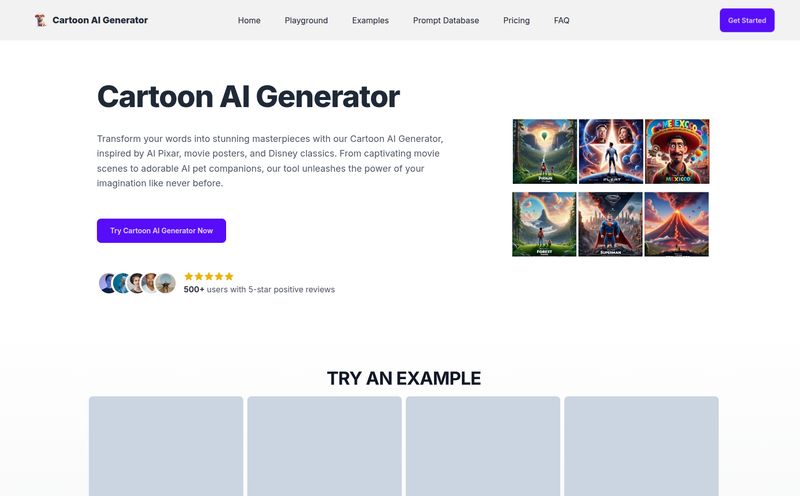That Sinking Feeling When You Have to Animate Something
You know the feeling. You’ve got this brilliant idea for a game, a short film, or even just a killer social media post. You’ve modeled the perfect character. They look great. They’re full of potential. And then it hits you. That cold, creeping dread. You have to make it move.
I’ve been there. I’ve spent more nights than I'd like to admit wrestling with rigging in Blender, fueled by lukewarm coffee and pure spite. Keyframing, inverse kinematics, motion paths... it's a mountain of a learning curve. For every one person who masters it, there are probably a hundred of us who just quietly close the program and go lie down for a bit. It’s a huge bottleneck for creativity. It’s tedious. It’s expensive if you outsource it. It’s just… hard.
So, when a new tool pops up on my radar, flashing a shiny promise of making 3D animation “100x faster,” my professional-blogger-cynicism kicks in immediately. But so does my hope. The tool is called Cartwheel, and it’s not just another plugin; it’s a full-throated attempt to change how we approach character animation using AI. But does it stick the landing?
So What is This Cartwheel Thing, Anyway?
In a nutshell, Cartwheel is an AI-powered platform designed to take the grunt work out of 3D character animation. You give it a character, you tell it what kind of motion you want, and its AI engine generates the animation for you. Think of it less like a blank canvas and more like a high-tech puppet theater where you’re the director, and the AI is your master puppeteer, already knowing a library of moves.
It’s built for pretty much anyone: indie game devs trying to populate their worlds, filmmakers prototyping scenes, advertisers needing a quick character spot, or even social media creators wanting to stand out. The goal is to get you from a static 3D model (a T-posing statue of despair) to a fully animated, exportable character in a fraction of the time. A bold claim, for sure.

Visit Cartwheel
The Features That Actually Get Me Excited
Alright, let’s get past the marketing fluff. A tool is only as good as its features. After poking around and looking at what they offer, a few things really stand out to me as genuinely useful, not just gimmicky.
From Zero to Hero: Your Characters, Your Way
This is a big one. You're not locked into a proprietary ecosystem of weird-looking preset characters. Cartwheel gives you options. You can type a description or upload a piece of concept art and have its AI generate a character for you. That's pretty cool for rapid ideation. But more importantly, for people like me who already have their own creations, you can upload your own custom 3D characters. The ability to bring in your own `.fbx` or `.obj` files is a non-negotiable for any serious workflow, and they nailed it. It means you can keep your unique art style and just use Cartwheel for the heavy lifting of animation.
The AI Magic Wand: Motion Generation and Blending
Here’s the core of the platform. Instead of setting keyframes, you use a system of “Spins” (we’ll get to that in the pricing). You can pick from a motion library or use text prompts—something like “a happy, jaunty walk” or “a tired, stumbling run.” The AI then generates that motion onto your character. The really clever part is the ability to automatically blend complex motions together. So, you can transition from that jaunty walk into a sudden jump and then a roll, and the AI handles the in-between stuff. Anyone who has tried to manually blend animation clips knows what a headache that can be. This feature alone could be a lifesaver.
Getting Your Work Out Into the World
A fancy animation tool is useless if you can’t get your animations out of it. The export options here are solid. You can export as a simple video, or get down to business with industry-standard formats like .bvh, .fbx, and .glTF. This means you can take your animations directly into game engines like Unity or Unreal, or other 3D software for further refinement.
But here's the bit that made me sit up straight: the Professional plan lets you export to Maya with extended rig features. This is a clear signal that Cartwheel isn't just for hobbyists. They're giving professional animators a pipeline to use AI for base motions and then bring it into Maya for fine-tuning. That's smart. Really smart.
Let's Talk Money: Breaking Down the Cartwheel Pricing
Okay, the inevitable question. How much is this going to set me back? The pricing structure is actually pretty logical and scales well from curious beginners to full-time studios. I've always felt that a good SaaS tool should have a free tier that's genuinely useful, and Cartwheel delivers.
| Plan | Price | Who It's For |
|---|---|---|
| Creator | $0 / month | Hobbyists, students, or anyone who wants to try it out. 150 Spins/mo is enough to get a feel for the workflow and make a few cool things. |
| Professional | $39 / month | Freelancers, indie devs, and small creative teams. You get 1,500 Spins and, critically, those pro export options for Maya. This seems like teh sweet spot for most serious users. |
| Unlimited | $95 / month | Small studios or power users who are animating constantly. Unlimited spins means you never have to worry about credits, and you get priority support. |
The “Spins” are basically their credit system. Each time you generate or significantly modify a motion, it costs a spin. It’s a fair way to meter usage, and the free tier is generous enough that you won’t hit the paywall in five minutes.
Is It All Sunshine and AI-Generated Rainbows?
So, what’s not to like? Honestly, based on the info, it’s hard to find an explicit downside. But as a seasoned pro, I have some… let's call them professional curiosities. Some might argue that AI tools stifle the art of animation. I get that, but I see this more as a way to handle the boring parts so you can focus on the performance.
My main question mark is around the quality and nuance of the AI's output. Can it truly capture subtle emotion, or is it just a library of generic movements? The promise of blending motions is fantastic, but the devil is in the details—how seamless are those transitions really? Will there be weird foot-sliding or janky physics? These are things you only discover with hands-on use. I'm also curious about the limits of the character generator. It's a great feature, but how much control do you really have?
This isn't a knock on Cartwheel, by the way. It’s just the healthy skepticism that comes from seeing dozens of “game-changing” tools over the years. The proof, as always, will be in the pudding. Or in this case, the exported `.fbx` file.
So, Who Is Cartwheel Actually For?
I see a few groups getting a massive boost from this.
- Indie Game Developers: This is the big one. Imagine being a solo dev and being able to create dozens of NPC animations in a single afternoon instead of weeks. It could literally be the difference between a static, lifeless world and a dynamic one.
- Content Creators & Marketers: Need a quick animated character for a YouTube intro or an ad? This is a much faster and cheaper route than hiring an animation studio for a small project. The mobile accessibility is a huge plus here too.
- Animators & 3D Artists: For pros, this isn’t a replacement. It’s an accelerator. Use it to block out scenes, generate base motion cycles, or quickly prototype ideas for a client before committing to hours of manual keyframing. The professional Maya pipeline shows they understand this audience.
Frequently Asked Questions about Cartwheel
- Can I really use my own custom 3D characters with Cartwheel?
- Yes, absolutely. The platform supports uploading your own characters, which is a key feature for anyone with an established art style or specific character models they need to animate.
- What exactly are 'Spins' in the pricing plans?
- Spins are the credit system Cartwheel uses. You use a spin when you ask the AI to generate a motion. It's their way of managing the computational cost of the AI generation. The free plan gives you 150 per month to start.
- Is Cartwheel a replacement for software like Blender or Maya?
- Not really. It's more of a specialized tool that supercharges one part of the workflow: character animation. You’d still use Blender or Maya for modeling, rigging, texturing, and final scene assembly. Cartwheel is designed to work with those programs, not replace them.
- Is my work secure when I upload it?
- According to their information, yes. They state that user work is secure and, importantly, deletable. This is crucial for professionals working on sensitive or unannounced projects.
- Can I use it for professional, commercial work?
- For sure. The export formats and the specific Maya pipeline in the Professional and Unlimited plans are clear indicators that it's built for commercial use cases in games, film, and advertising.
- Does it work on a phone?
- Yes, they mention it's accessible on mobile browsers. While I probably wouldn't do my final detailed work on a tiny screen, the ability to check on a render or try out a quick idea from anywhere is a fantastic touch.
Final Thoughts: A Cartwheel Worth Doing?
Look, the world of AI tools is getting crowded. A lot of them are fun novelties that don't really fit into a real workflow. From where I'm standing, Cartwheel seems different. It’s targeting a genuine, persistent, and expensive pain point in the creative industries.
It’s not about replacing artists. It's about augmenting them. It’s about giving the little guy—the solo dev, the small creator—a fighting chance to bring their ideas to life without needing a Hollywood budget or spending a decade learning a single skill. Will it make animation 100x faster? That number feels like marketing, but even if it’s 10x faster, or even 2x faster, that’s a revolution for a lot of people.
I’m optimistic. Cautiously, but genuinely optimistic. This is one AI tool I’ll be keeping a very close eye on.
Reference and Sources
- Cartwheel Official Website (Note: This is a presumed URL)
- Blender Foundation - For comparison on traditional 3D workflows.
- Autodesk Maya - The industry standard software Cartwheel integrates with.



